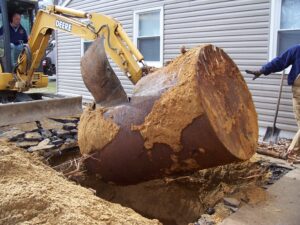 Many older underground storage tanks (USTs) need be be closed properly to protect human health and the environment. Contaminated ground water is usually the first sign that you have a problem with a UST. For the best tips on closing a UST we need to first know if you want to close it temporarily or permanently. If there is an old oil tank in your property, an oil tank removal is highly recommended for your family’s safety. If the tank has caused damaged to your home’s foundation, you may also need to hire a foundation repair company to determine the extent of the damage and do the necessary repairs.
Many older underground storage tanks (USTs) need be be closed properly to protect human health and the environment. Contaminated ground water is usually the first sign that you have a problem with a UST. For the best tips on closing a UST we need to first know if you want to close it temporarily or permanently. If there is an old oil tank in your property, an oil tank removal is highly recommended for your family’s safety. If the tank has caused damaged to your home’s foundation, you may also need to hire a foundation repair company to determine the extent of the damage and do the necessary repairs.
Closing a UST Temporarily
You may temporarily close your UST for up to 12 months…
- Continue to monitor for leaks by maintaining the UST’s leak detection
- Continue to monitor and maintain any corrosion protection systems.
- If you are going to temporarily closed the UST for more than 3 months, leave vent lines open, but cap and secure all other lines, pumps, manways, and ancillary equipment.
- The distance to drinking water wells and surface water, volume of material stored, worse case weather conditions, drainage patterns, land contours, and soil conditions must also be taken into account. Regular maintenance done by a well drilling services company will also keep your water well clean and functioning properly.
If a leak is discovered, quickly stop the leak and notify your regulatory authority and take appropriate actions to clean up the site.
Options After 12 Months of Temporary Closure…
- Permanently close the UST if it doesn’t meet the applicable requirements for new or upgraded USTs (except for spill and overfill)
- Ask your regulatory authority for an extension beyond 12 months (a contamination assessment will have to be done before asking)
- Keep the UST temporarily closed as long as the UST meets the applicable requirements for new or upgraded USTs (except for spill and overfill) fulfills the other requirements of temporarily closed USTs
Closing a UST Permanently
- Notify the regulatory authority at least 30 days before you close it
- Determine if there is contamination from your UST in the surrounding environment (monthly vapor or groundwater monitoring, or a site assessment) If there is contamination, you must take the proper actions to clean it.
- Keep records for three years that demonstrate closure requirements compliance and a record of the excavation assessment you took to determine if there was any contamination.
- Either remove the UST from the ground or leave it in the ground. In both cases, the tank must be emptied and cleaned by removing all liquids, dangerous vapor levels, and accumulated sludge. These potentially very hazardous actions must be done by professionals who follow standard safety practices. If you leave the UST in the ground, fill it with a chemically inactive solid (ie. sand).
- Check with your state agency for state-specific closure requirements
Environmental Risk Management can examine your underground storage tanks (USTs) and help with their temporary or permanent closure .
ou know Environmental Risk Management’s answers to all of these questions.
Contact Us (859-689-9222) for a Free Consultation!
—
 About Environmental Risk Management
About Environmental Risk Management
1-Source Turnkey Environmental & Safety Services
Since 1989, Environmental Risk Management has been providing responsive, client focused 1-source turnkey solutions for a wide variety of environmental safety challenges. With our experience and extensive network of diverse internal and external resources, our clients trust us to provide quality Environmental & Safety Services for their businesses. Our environmental compliance specialists recognize the need to consult with private industry and the business community and our goal is to ensurer our client’s are complying with complex environmental regulations and minimizing their environmental liabilities.
> Learn More
